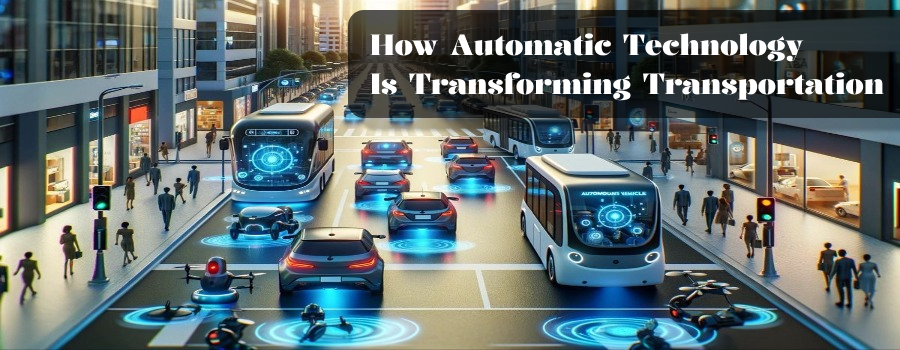Posted on: Sep 10, 2024
Estimated reading time: 0 minutes
How Automatic Technology is Transforming Transportation.

Autonomous technology, which ensures convenience, efficiency, and safety, is changing the way we move. Examples of this include self-driving cars and smart traffic management systems.
We will look at how autonomous technology is changing transportation in this blog post, as well as some implications for the future.
Revolutionizing Road Travel:
Leading the way in automated transportation technology are self-driving cars.
These autonomous vehicles navigate roads without the need for human assistance by utilizing a mix of sensors, cameras, and artificial intelligence.
Intending to lower traffic accidents and increase transportation efficiency, major corporations like Tesla, Waymo, and Uber are making significant investments in this technology.
Autonomous vehicles have advantages that go beyond the personal benefits of car owners. By enabling 24/7 operation and cutting labor costs, they promise to revolutionize delivery services and logistics. Furthermore, the widespread use of autonomous vehicles may lessen traffic in cities and the requirement for substantial parking infrastructure.
Automatic Technology in Public Transit Systems:
Automatic technology is also causing a major transformation in public transit systems. The increasing prevalence of automated trains and buses brings increased efficiency and dependability.
Cities such as Copenhagen and Paris, for instance, have effectively introduced driverless metro systems that function with very little human supervision.
Key Advantages:
Enhanced reliability: Automated systems can meet deadlines with greater precision, which minimizes delays and enhances the quality of the services.
Cost Savings: By eliminating the need for human operators and increasing fuel efficiency, automation can save operating costs.
Enhanced Safety: Automated public transportation systems can improve pedestrian and passenger safety by reducing the likelihood of human error.
Many public transportation systems are using semi-automatic technologies in addition to fully autonomous vehicles to improve service. Passengers are benefiting from increased convenience and efficiency from automated fare collection, real-time tracking, and predictive maintenance, to name just a few.
The Impact of AI and Machine Learning on Transportation Efficiency:
Transport system optimization is heavily reliant on machine learning and artificial intelligence (AI). Large-scale data analysis is done by these technologies to enhance vehicle maintenance, traffic control, and route planning.
AI systems, for example, can forecast traffic patterns and recommend alternate routes to ease congestion.
Additionally, machine learning is being used to improve autonomous car performance by allowing them to learn from real-world driving situations and continuously develop their decision-making abilities.
Moreover, AI-driven predictive maintenance lowers downtime and boosts service reliability by assisting transit authorities in seeing possible problems before they become serious.
Enhancing Safety Through Automation in Transportation:
Automation is changing the game in the area of transportation safety, which is of utmost importance. Road accidents are already being decreased by advanced driver-assistance systems (ADAS), such as adaptive cruise control, lane-keeping assistance, and automated emergency braking.
Notable Feature of ADAS:
With adaptive cruise control, your car will automatically change its speed to keep a safe distance from the car in front of you.
Lane-keeping assistance: offers steering cues or warnings to assist drivers in staying in their lane.
Automatic Emergency Braking: This system recognizes possible collisions and applies the brakes in an attempt to stop or lessen them.
Collision avoidance systems and real-time vehicle condition monitoring are examples of automated safety features in public transport. These innovations enhance the general safety of pedestrians and other road users in addition to protecting passengers.
We should anticipate seeing even more advanced safety features incorporated into our transportation networks as automation develops.
Transportation's Future: Embracing Automation
Automation and technology will surely be entwined in the transportation of the future. We can anticipate even more cutting-edge solutions that will revolutionize travel as innovations continue to develop. Transportation systems will become even more capable, safe, and easy to use as a result of the integration of the Internet of Things (IoT), machine learning, and artificial intelligence (AI) technologies.
What to look forward to?
Vehicle-to-Everything (V2X) Communication: To improve safety and traffic flow, vehicles will talk to each other and the infrastructure.
Electric Autonomous Vehicles: By combining autonomous and electric technologies, transportation solutions that are both efficient and sustainable can be produced.
High-speed rail and the Hyperloop: These innovative modes of transportation have the potential to transform long-distance travel at a never-before-seen level of efficiency and speed.
Conclusion:
The transportation industry is undergoing a rapid technological transformation that will usher in a new era of efficiency, safety, and convenience.
These developments are opening the door for a more integrated and intelligent transportation ecosystem, from automated public transportation and self-driving cars to intelligent traffic management systems and sophisticated driver assistance.
Transportation promises to become more exciting and seamless in the future as we continue to embrace these advancements.